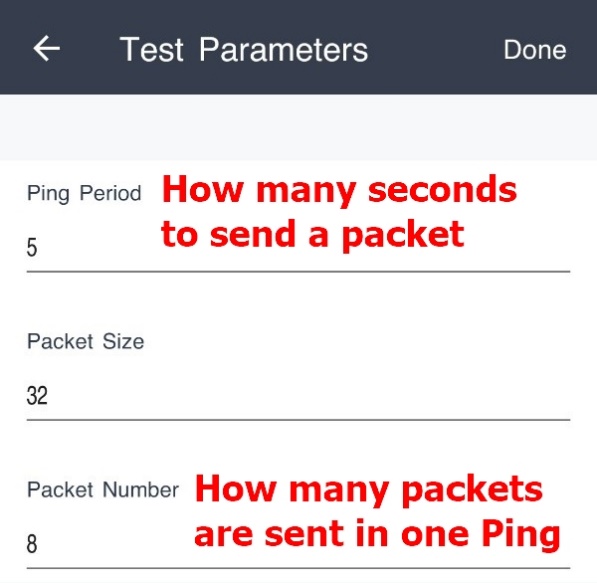How to use the Ping tool in Omada APP
TL-SG2008P , TL-SG3452X , TL-R605 , TL-SG3452XP , EAP245( V3 V4 ) , EAP230-Wall , TL-SG2210P( V3 V3.20 V4 V5 ) , SG2210MP , TL-SX3008F , ER7206 , ER8411 , EAP115( V4 V4.20 V5 ) , EAP235 , TL-SL2428P( V4 V4.20 V5 V6 ) , TL-SX3016F , S4500-8G , SG2218 , SG3428 , Omada Software Controller( V5 ) , TL-SG3452P , TL-SG3428X , ER605 , EAP650-Outdoor , SL2428P , S4500-8GHP2F , EAP653 UR , EAP660 HD , AP9665 , S4500-16G2F , TL-SG3428XF , ER707-M2 , EAP673 , EAP110( V4 V5 ) , Omada Cloud-Based Controller , EAP670 , EAP235-Wall , TL-SG2210MP , SG3210 , SG3452 , SG3452X , TL-SG3210XHP-M2 , S5500-24GP4XF , EAP225( V3 V3.20 V4 V5 ) , TL-SG2428P , EAP610-Outdoor , EAP115-Wall , SG3428XF , SG2428LP , EAP225-Wall( V2 ) , EAP225-Outdoor , EAP223 , SX3008F , SG3428MP , SG3428X , SG3452P , EAP265 HD , SX3016F , EAP620 HD , SG2428P , SG2008P , SG3452XP , EAP613 , EAP610 , EAP653 , TL-SG3428 , TL-SG2218 , SG2210P , EAP655-Wall , S5500-4XHPP2XF , EAP615-Wall , S5500-8MHP2XF , TL-ER7206 , TL-SG3428MP , TL-SG2008( V3 V4 ) , EAP650 , TL-SG3452 , TL-SG3210( V3 ) , EAP690E HD , TL-SX3206HPP , EAP623-Outdoor HD , EAP650-Wall , SG3428XMP , EAP110-Outdoor( V3 V4 ) , TL-SG3428XMP , SX3206HPP
Recent updates may have expanded access to feature(s) discussed in this FAQ. Visit your product's support page, select the correct hardware version for your device and check either the Datasheet or the firmware section for the latest improvements added to your product.
1. What is a Ping Tool
Ping tools allow network managers to detect the reachability of a host a local or internet-based network. They can use an IP address or domain name. TP-Link has built a Ping tool into the Omada APP. You can use it to check the connection to any node right from your phone.
Note: The built-in ping tool only provides the most basic function of Ping in the Omada APP. If you want to use the more advanced functions of a ping tool please use the command line function built into a computer or other specialized apps.
2. When would you use a Ping Tool
When you are having trouble connecting to the Internet or cannot gain access to a specific host. You can use a ping test on the wireless clients, and to test an unreachable node’s connectivity to determine where an issue may lie.
3. Commonly used addresses on a Ping Test
- Uplink AP IP address.
- Uplink Switch IP address.
- Uplink Router IP address.
- WAN IP address of Router.
- Public DNS server such as 8.8.8.8, 1.1.1.1, etc.
- Public domain name.
4. How to use the Ping Tool in the Omada App
- Open and login to your Omada APP, then click the top left icon
 to open the sidebar
to open the sidebar - In the Sidebar tap on ‘Network Tools’
- Tap on ‘Parameters’ to customize your Ping test

- Tap on ‘Done’ to save the parameters.
- Go back to the previous page, type in the IP address or domain name, then tap ‘Ping’
- Review the results to determine which part of link is having problems
Is this faq useful?
Your feedback helps improve this site.
What’s your concern with this article?
- Dissatisfied with product
- Too Complicated
- Confusing Title
- Does not apply to me
- Too Vague
- Other
We'd love to get your feedback, please let us know how we can improve this content.
Thank you
We appreciate your feedback.
Click here to contact TP-Link technical support.
TP-Link Community
Still need help? Search for answers, ask questions, and get help from TP-Link experts and other users around the world.
This website uses cookies to improve website navigation, analyze online activities and have the best possible user experience on our website. You can object to the use of cookies at any time. You can find more information in our privacy policy . Don’t show again
This website uses cookies to improve website navigation, analyze online activities and have the best possible user experience on our website. You can object to the use of cookies at any time. You can find more information in our privacy policy . Don’t show again
Basic Cookies
These cookies are necessary for the website to function and cannot be deactivated in your systems.
TP-Link
SESSION, JSESSIONID, accepted_local_switcher, tp_privacy_base, tp_privacy_marketing, tp_smb-select-product_scence, tp_smb-select-product_scenceSimple, tp_smb-select-product_userChoice, tp_smb-select-product_userChoiceSimple, tp_smb-select-product_userInfo, tp_smb-select-product_userInfoSimple, tp_top-banner, tp_popup-bottom, tp_popup-center, tp_popup-right-middle, tp_popup-right-bottom, tp_productCategoryType
Youtube
id, VISITOR_INFO1_LIVE, LOGIN_INFO, SIDCC, SAPISID, APISID, SSID, SID, YSC, __Secure-1PSID, __Secure-1PAPISID, __Secure-1PSIDCC, __Secure-3PSID, __Secure-3PAPISID, __Secure-3PSIDCC, 1P_JAR, AEC, NID, OTZ
Zendesk
OptanonConsent, __cf_bm, __cfruid, _cfuvid, _help_center_session, _pendo___sg__.<container-id>, _pendo_meta.<container-id>, _pendo_visitorId.<container-id>, _zendesk_authenticated, _zendesk_cookie, _zendesk_session, _zendesk_shared_session, ajs_anonymous_id, cf_clearance
Analysis and Marketing Cookies
Analysis cookies enable us to analyze your activities on our website in order to improve and adapt the functionality of our website.
The marketing cookies can be set through our website by our advertising partners in order to create a profile of your interests and to show you relevant advertisements on other websites.
Google Analytics & Google Tag Manager
_gid, _ga_<container-id>, _ga, _gat_gtag_<container-id>
Google Ads & DoubleClick
test_cookie, _gcl_au










